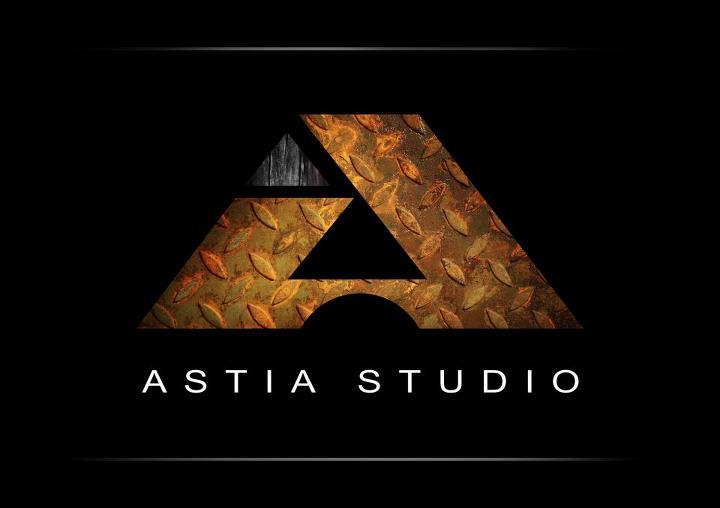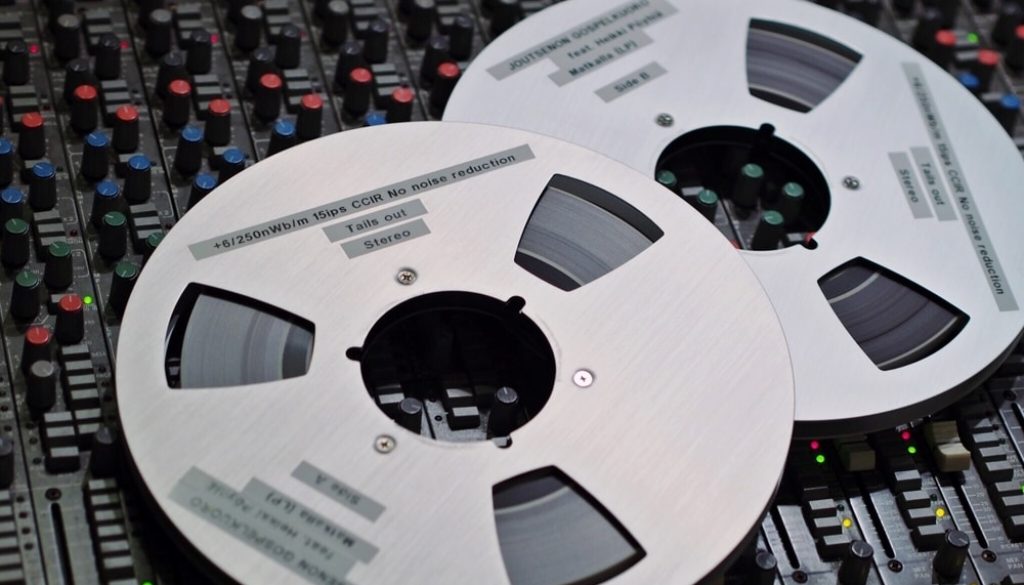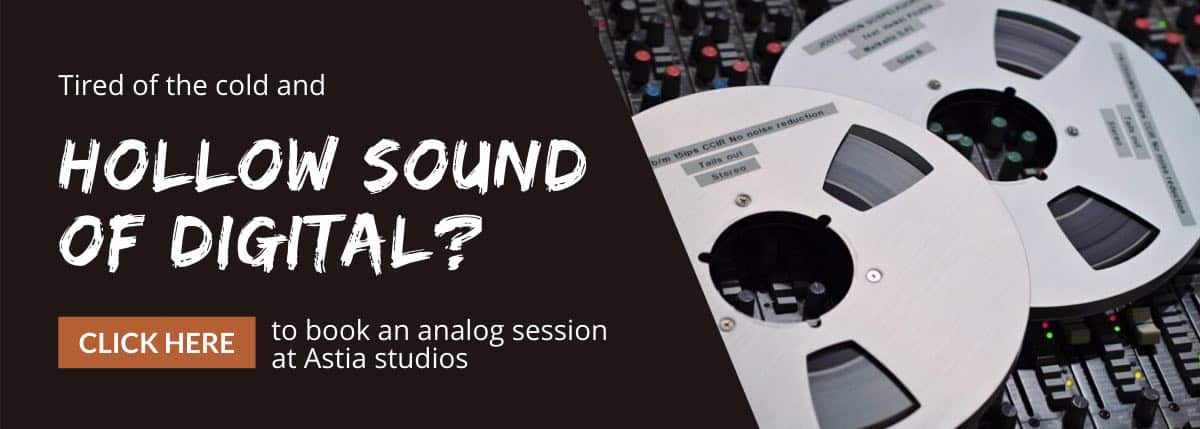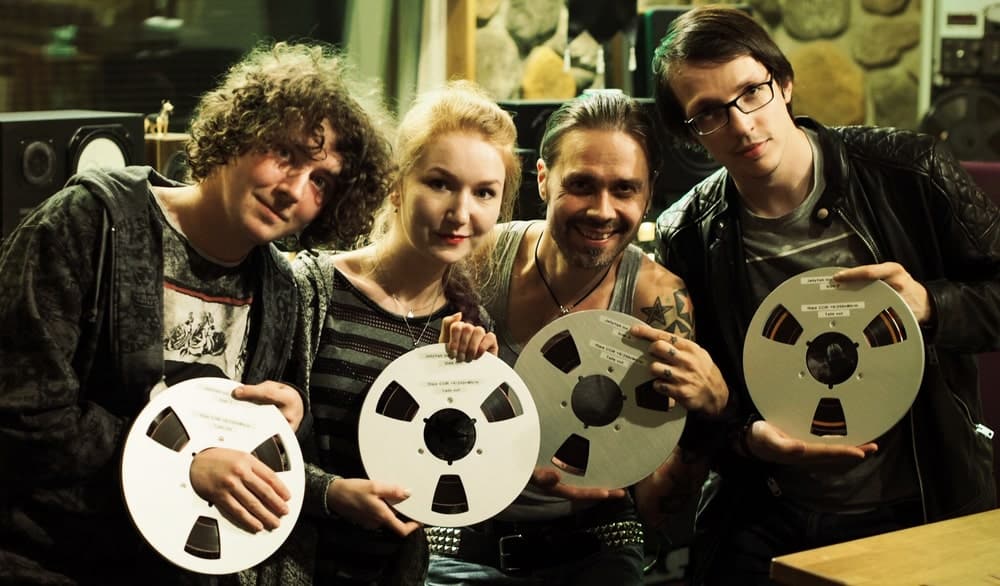You must be a world-class virtuoso to record on tape – and 4 other myths about tape recording
Tape recording – this once almost obsolete art of capturing energy and emotion we call music is making a comeback. As I know this topic inside out, I want to help you understand why you should record on tape. If you knew what I know, you neither would want to record on anything but tape. You will learn how tape recording is actually faster and how on DAW session you need to play a lot more accurate compared to tape recording. The amount of tracks needed to make a great recording might also come as a surprise. On this post we will bust 5 myths about tape recording.
Common myths about tape recording
Why even bother considering the old and complicated way or recording when DAW is handy and fast? You can’t even edit what’s on the tape! Fast and easy always comes with a price. Has the quality of the musicians declined as not so long ago all music was recorded on tape? From what I’ve heard that’s not the case as even a beginner can sound great when captured on tape. Let me guide you through some of the most common beliefs about recording on tape.
1. You must be a world-class virtuoso to record on tape.
FALSE
You might be so used to editing, combining takes and tuning your vocals that the tape recording scares you. “Fear not!” say I as you need those things with the digital recording only. Dozens of times I have recorded the same take on both the DAW and tape with the band playing live all at once. When we listen the recording from the computer, it sounds like we need to tune the vocals, few drum hits need editing and that the bass and guitar are not in sync. So we would either have to edit a lot or record again.
When listening the very same take captured on tape, the vocals need no tuning, drums sound solid and the bass locks tightly in with the other instruments. And it is the very same take that sounded awful on DAW! Even though it may sound strange or even unbelievable; this is the result every single time we do the comparison. Every band who I’ve had the pleasure of showing the difference is amazed by it.
If you are not able to play a live show, then you definitely should not record on tape or on any other platform. Yet, if you do play live shows, you most certainly have no problem recording on tape. I have recorded several bands who are by far non-professionals, yet when recorded on tape, they sound super tight and energetic. The first tape session is always the best as that’s when you get to experience the huge difference yourself. You’ll hear your music as it really is and the surprise is always a very pleasant experience.
You definitely do not have to be a virtuoso to record on tape. The first tape recording myth is busted.
2. You must record everything live and cannot fix anything.
NOT TRUE
Or actually partly true, but it’s more just a recommendation. When you record on tape live, there is this drive and energy factor that seems to be pretty much diminished on computer recording. With DAW it’s not fully gone but radically diminished. So your music will benefit from recording live no matter what recording format you use, yet it is not a must. The most horrifying thing you can do is to record each instrument to a click track without listening to any other instruments, and then combine the tracks during mixing hoping it will turn out as music. Nothing could be as far from the essence of it. And unfortunately this is pretty common among home recording.
I recommended recording the basic tracks live to get more energy and drive. When recording to tape you can overdub as much as you want, exactly as you would on a DAW session. The only difference is that you cannot decide which take to use after the recording and do any edge-editing. When you do such editing and decisions during recording, it saves time. On tape recording from that point on when you press record you delete the previous take on the selected track(s) until you press stop.
It is very common that we play the basic tracks live and then overdub just the wrong note(s) or the whole guitar track. As it is with music in general: it always depends on the situation as there are no rules. When recording to tape, you can fix even the small things like one word or one note from the chord section or solo. We can do it when needed. Should you is a whole another blog post topic.
Must you record live because there is no possibility of fixing the mistakes? The answer in short to that is “no” and two tape recording myths are busted.
3. Working with tape is slow and the sessions take very long.
THE TOTAL OPPOSITE
As tape seems to forgive the small mistakes, we get much more done in a lot shorter time. You actually save money as tape sessions are fast and the sound quality is on a whole another level compared to DAW sessions. One song per day is the norm with tape including recording, mixing and mastering. Every band I work with is blown away by how much faster working with tape is.
The recent album sessions I’ve done have been approximately 12 – 16 days including recording, mixing and mastering. Sure with tape too we can spend a month or two on the album. Yet, as there is this place called “a rehearsal room” and once you understand the essence of it, especially the “rehearsal” part, things literally develop from there. I have done a whole album in just one day on tape and nope, it wasn’t a punk trio but a 12-piece band recorded live to stereo. It was like a live show in studio as they had such an awesome energy and drive!
Every band should rehearse at the rehearsal room until they know all the songs and parts. Read more how you can save money by using less studio time on my Prepare For A Session blog post here. Spend more time at the rehearsal room and you will become a much better musician. You will need less time in studio = save money. I encourage bands to come to the studio well-rehearsed to “capture the moment”.
Tape sessions are fast and you don’t have to spend a fortune on a ridiculous amount of studio time. Three tape recording myths are busted.
4. We can’t record on tape as 24 tracks is not enough.
UNTRUE
After 25 years of recording, mixing and mastering music on both tape and DAW, I have come to a clear conclusion why we need so many tracks. It’s very common to have 80 – 130 tracks per song and some even spend the time to have 1.300 individual tracks on their music. I’ve done my good share of such studio work too.
From what I have learnt, and this comes from a simple A/B comparison as it is the easiest way to solve any problem in life; when converting audio from analog to digital a lot of information is lost. You have no idea how much if you monitor from the output of the sound card.
My world turned upside down when for the first time in years I changed my monitoring from the soundcard output to before the soundcard. And I couldn’t believe my ears! That was the moment I realised how much information is lost and encourage you to test it yourself. The difference is minimal if you use a digital amp or a digital speaker distributor. The signal path must be full analog and then the truth dawns on you too. The difference is much bigger than you would expect.
As information is lost when recording on computer, we need to compensate it by adding more tracks. Instead of just two rhythm guitars we double them to have four. We triple the lead vocals to make it bigger. Instead of just two backing vocal tracks we have 8, 16 or even 48. Everything needs doubling or tripling and what you do not yet know is; the more tracks you add the smaller the sound.
The first tape session amazes musicians as they tend to add more tracks than needed. Once they hear how they sound when recorded live without any additional tracks, it sometimes is hard to comprehend how complete and full the sound already is. If you quadruple the rhythm guitar to tape, on most cases it is way too much and you will make your music sound bad.
On many 70’s albums you don’t have any doubling and still they sound full and rich. Even on newer stuff like on Lenny Kravitz’s Are You Gonna Go My Way song there is just two guitars; one on the left and the other on the right speaker. The lead guitar that’s on the right isn’t playing thru-out the song and so the right speakers lacks guitar. Yet, no-one ever said: “Are You Gonna Go My Way would be a great song if it had more guitar!”.
With tape less is more. Four tape recording myths are busted.
5. Tape recording is not suitable for the music we make.
FALSE
So far I haven’t heard a single band that tape recording would not benefit. I’ve recorded acoustic music, rap, metal, rock, choir albums, pop, blues and black metal on tape and the list goes on. When recording your drums on tape, all the small nuances like the ghost notes on snare, the energy of the snare hit, your groove and all the money you spent on both the drums and on the new drum heads will be there. No-one will edit your groove and replace your drums with samples.
For guitar and bass the tape captures the touch of the musician much more accurate. It is pretty amazing as playback from tape sounds like sitting next to your amp. You can hear it even when listening the final mix from a bad quality mp3 on YouTube or Spotify. Your style and touch will be readable unlike on most cases with the computer recording. To amaze the violin player with the presence-effect is every time highly rewarding.
Keyboards sound full and rich. When I recorded on computer we usually doubled and tripled every keyboard part. And we had to have them in different octaves. When recording on tape, you don’t need any of that. It is something you need to experience yourself to understand. The difference is so huge!
With vocals it’s pretty common that when we listen the final mix in the control room, the vocalist has a tear in the eye. The moment is very emotional as tape recording delivers emotion. They have never heard their voice captured with all the small nuances along with the facial expression.
Most vocalists are familiar with the fact that no matter how you twist your face during computer recording, the emotion along with the facial expression is next to note. The listener can literally feel the emotion of the vocalist.
This is something every genre would benefit so five tape recording myths are busted.
Tape recording myths busted
You might be afraid that your skills are not good enough for tape recording. Even the bands who some would call beginners can sound awesome on tape when guided correctly. Tape sessions are fast and 24 tracks is more than enough. In case we need more tracks, we can sync two tape machines together. Every genre benefits from tape recording.
You can easily spot the difference by listening the analogue-era vinyls and compare them to computer-era vinyls. Once you know what to focus on, the difference is so huge that you cannot believe why you haven’t spotted it before. You can read step-by-step instructions on my Vinyl Records And How To Improve Enjoying Music post here.
Thank you very much for busting five tape recording myths with me. It was a pleasure to take you through these most common false beliefs. I hope this post will encourage you to take the step and make your first tape session. Once you do it with the right person and in the right facility, it is a life-changing experience in the most positive way.
If this post was helpful, please share it on social media. This way you will help your friends to benefit from the information.
To experience your music in great detail reserve a full analog tape session by clicking here. Thank you very much and all the very best!
Learn more about tape recording:
- “From Now On This Is The Only Way Erävesi Will Make Recordings”
– Case Study Erävesi - Jarmo Nikku: “The Sound Felt Natural (After Quite Some Time)”
– Case Study Seniors Clearwater Revival - FAQ about tape recording
Astia-studio is a full analog recording studio located in eastern Finland with 25 years of experience. Bands and artists from all over the world including USA and the furthest corner of Russia, Vladivostok have arrived to us for tape recording sessions.







05/09/2019 @ 8:55 pm
And then bring the master tape to the vinyl pressing plant. In some cases bring your master tape-recorder to avoid difference in machine adjustment. Right?
Avoiding the digital proces at the record pressing plant.
05/09/2019 @ 9:07 pm
Thank you for the comment Jelle. Yes, I highly recommend using a full analog signal path when it comes to vinyl records and cassettes. The difference is huge once you know what to focus on. You can easily hear the difference when comparing the original full analog vinyl record to a digitally re-mastered one. For example Santana’s Abraxas vinyl from the 70’s fills the room while 2015 digitally re-mastered vinyl record sound is “inside the speaker”. The phenomenon is pretty strange and with my demonstration on the subject I have amazed not only hundreds of professional musicians but also the local university professors, who have no explanation to it. Always keep the signal path analog as long as possible and make all vinyl from the tape. ? Have a great week & all the very best! ?